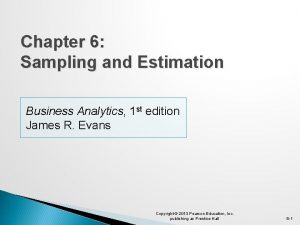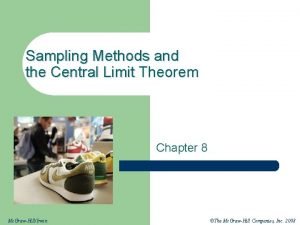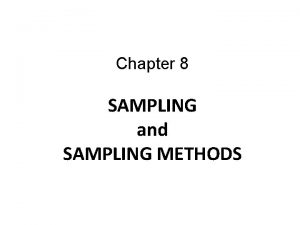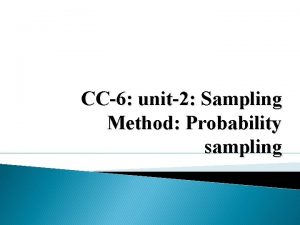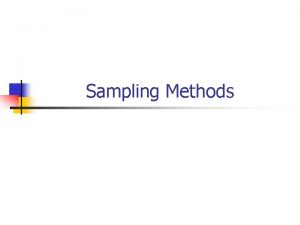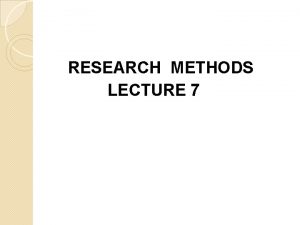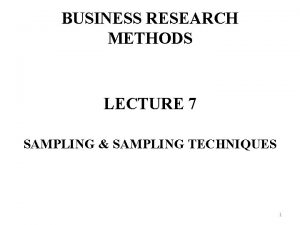SAMPLING PRINCIPLES Research Methods University of Massachusetts at














- Slides: 14

SAMPLING PRINCIPLES Research Methods University of Massachusetts at Boston © 2011 William Holmes 1

WHAT IS A SAMPLE? • Part of a whole. The larger whole is a population. The subgroup is the sample. • Some selected by scientific procedures • Some selected by haphazard procedures • Some selected with deliberate bias 2

WHY DO YOU NEED A SAMPLE? • To make generalizations about a population. • Populations are expensive to get. • Populations are difficult to obtain. • A good sample is better than a poor population 3

HOW DO YOU GET A GOOD SAMPLE? • Fit the sampling procedure to the population, the resources, and the moral and legal constraints. • Choose the most scientific procedure feasible. • Choose the largest sample possible. • Choose probability samples over nonprobability. 4

TYPES OF SAMPLES • Non-probability Sample— haphazard, convenient • Probability Sample— systematic • Fraudulent Sample— deliberately biased 5

WHAT ARE PROBABILITY SAMPLES? • Follows standard procedure for everyone in population • Chance of selection using procedure is known • Unintended, random bias is possible 6

TYPES OF PROBABILITY SAMPLES • • Simple Random Sample Systematic Sample Cluster Sample Stratified Sample 7

WHAT ARE NONPROBABILITY SAMPLES? • Uses Non-standardized (Variable) procedures • Chance of selection is unknown • Unintended, systematic bias may creep in 8

TYPES OF NON-PROBABILITY SAMPLES • Convenience Sample—not deliberately biased • Purposive Sample—chosen to be similar to a population, according to the chooser • Quota Sample—chosen to be similar to a population, according to known characteristics • Snowball Sample—using referrals from known members of a population 9

FRAUDULENT SAMPLES • Artificially constructed to show a characteristic or a relationship • Violates norms of science and research • Selects cases to prove a point • Concerned with non-scientific ends —money, promotion, ideology. 10

HOW DO YOU TELL IF YOU’VE GOT A GOOD SAMPLE? • Check for scientific procedures • Check for ethical and legal requirements • Compare with known population characteristics • Look for weirdness 11

SELECTING A RANDOM SAMPLE • 1. Define population • 2. Get list of random numbers or choose a random process • 3. Make a decision rule to select cases • 4. Assign random numbers • 5. Select persons who meet criteria 12

SELECTING A SYSTEMATIC SAMPLE • 1. Define population. • 2. Decide on sample size. • 3. Divide population into groups where the number of groups equals the sample size. • 4. For first group, select one by simple random sampling. • 5. Count down on list a number equal to the group size. • 6. Select each person at end of count. Repeat. 13

SAMPLING EXAMPLE Person Age Gender Rdn Nbr* Grp 1 18 1 4# 1 2 25 1 3 1^ 3 21 2 7 2 4 34 2 5 2^ 5 22 1 1 3 6 19 1 2# 3^ Rdm mean age=20. 3 7 33 2 7 4 Rdm mean sex=0. 67 8 20 1 7 4^ Syst mean age=24. 4 9 21 2 5 5 Syst mean sex=0. 60 10 24 2 6# 5^ Random Number Criteria: select persons with even random numbers Systematic Sample start: person number 2 *from random number table. #Selected for random sample. ^Selected for systematic sample. 14
 Types of sampling in research
Types of sampling in research Sampling methods in qualitative and quantitative research
Sampling methods in qualitative and quantitative research University of massachusetts building authority
University of massachusetts building authority Research methodology lecture notes doc
Research methodology lecture notes doc Probability sampling vs non probability sampling
Probability sampling vs non probability sampling Panel sampling
Panel sampling Stratified sampling vs cluster sampling
Stratified sampling vs cluster sampling Contoh checklist observasi psikologi
Contoh checklist observasi psikologi Cluster random sampling vs stratified
Cluster random sampling vs stratified Probability sampling meaning
Probability sampling meaning Natural sampling vs flat top sampling
Natural sampling vs flat top sampling Sampling techniques psychology
Sampling techniques psychology Sampling and estimation methods in business analytics
Sampling and estimation methods in business analytics Audit sampling methods for tests of controls
Audit sampling methods for tests of controls Sampling methods and the central limit theorem
Sampling methods and the central limit theorem












